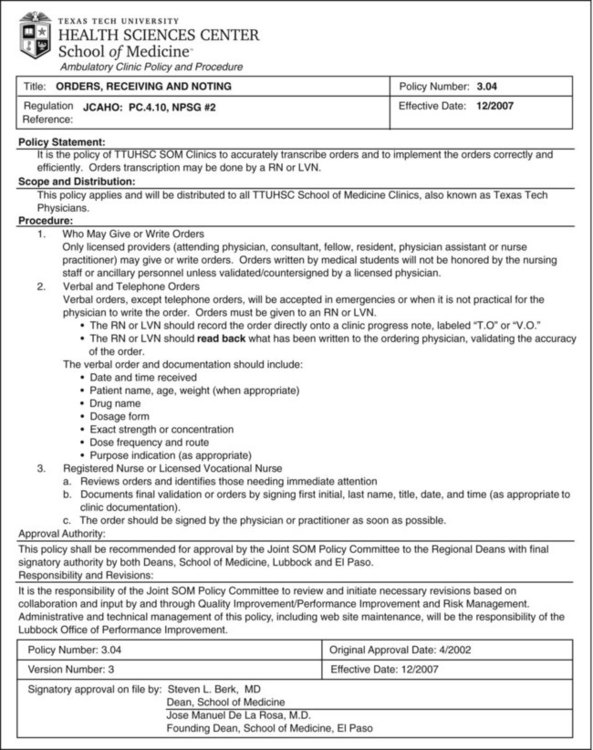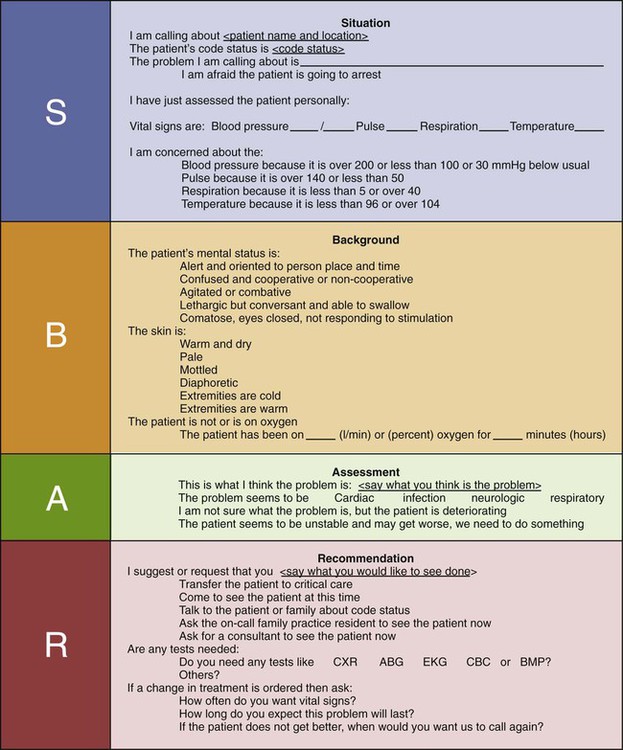1. Identify the principles of good communication. 2. Discuss the importance of good communication in the management of care. 3. Identify various means of communication used in health care. 4. Review the components of a change-of-shift report. 5. Discuss SBAR communication and its use in health care. 6. Identify principles of communication when dealing with patients/families and staff members. 7. Review communication principles when dealing with conflict resolution. Communication forms the basic principle when managing and coordinating care. Much of what nurses do needs to be communicated to the patient, family, and fellow staff members. Professional communication sets the tone of our management style and often the tone of the unit in which we work. Communication and the lack of a consistent process for communication of patient condition have been cited as variables in the number of medical errors that occur in hospitals. A recommendation of the Institute of Medicine calls for hospitals to “develop a working culture in which communication flows freely” (1999, p. 180). Sullivan and Decker (1992) note five principles of effective communication: • Giving information is not the same as communication, which requires interaction, understanding, and response. For example, if a nurse asks a staff member to do something but the staff member does not understand, information has been given but communication has not occurred. • The sender of the communication is responsible for clarity. Nurses as well as nurse managers must make sure that their communication is clear—it is not the job of the receiver of the message “to translate.” If the receiver of the message has to translate the message, the possibility of error increases. For example, if you expect the unlicensed nursing personnel to report back to you immediately if a patient’s temperature increases, you need to specifically say just that. • Use simple, exact language. The sender of the message needs to use words that are easily understood by the receiver of the communication. The words need to be precise and unambiguous. A word about e-mail communication—”I” message language is inappropriate…professional e-mail needs to avoid the use of all slang and shortcuts. • Communication encourages feedback. Although feedback is not always positive, it is essential for making sure that the receiver understands the message. It is not enough to ask, “Did you understand?” because the answer may be an automatic “yes” because the receiver expects that is what you want to hear. Feedback can be verbal (“I do not understand what you said”) or nonverbal (rolling of eyes when asked to do a task). • Sender must have credibility. A credible sender is perceived as trustworthy and reliable. Receivers who think the sender is not reliable may ignore the message. • Use direct communication channels when possible. Direct communication (person to person, face to face, or in writing) is best because there is less chance of the message being distorted as it passes through senders. Face-to-face communication is preferred as it allows the sender to get immediate feedback about the message. In the new technological age, much of the interdepartmental and staff-to-staff communication involves electronic mail, or e-mail. Communication using such technology should follow the principles just stated but also needs to follow the basic principles of e-mail netiquette. Tschabitscher (2009) offers 10 rules for e-mail netiquette, which have been adapted as follows: 1. Use e-mail the way you want everybody to use it: Do not use it to send nonprofessional concerns. 2. Take another look before you send the message: Proofread your comments for appropriateness and confidentiality. 3. Quote original messages properly in replies: Make your e-mail replies easy to read by quoting in a useful manner. 4. Avoid irony, sarcasm, and emotional tones in e-mail: Keep the message objective. 5. Clean up e-mails before forwarding them: Forwarding e-mails is a great way of keeping track of a concern but make sure that the original idea is not lost. 6. Send plain text e-mails: Avoid fancy formatting of e-mails. Cutesy pictures are for personal, not professional, communication. 7. Writing in all caps is shouting: Caps are also difficult to read. 8. Ask before you send large attachments: Large attachments may clog e-mail systems. 9. The use of “smileys” raises an alarm: Avoid the use of emoticons, IM language, and Internet slang. 10. Avoid “me, too” messages: Content needs to be specific and complete. (Adapted from Top 26 Most Important Rules of Email Etiquette. Copyright 2009 by Heinz Tschabitscher, http://email.about.com/od/emailnetiquette/tp/core_netiquette.htm. Used with permission.) Nurses and nurse leaders also communicate with families and staff. Difficult situations often involve patients and staff and disagreements or complaints about the delivery of or assignments of care. According to Sullivan and Decker (1992), nurse leaders need to keep the following in mind when dealing with patient or staff issues: • Patients and their families are customers and should be communicated to with honesty and respect. Even if the communication involves dealing with a complaint, the customer needs to receive prompt and tactful assistance. The same philosophy is appropriate for an employee—he or she is a stakeholder in the work environment and also requires honesty and respect in communication. • Nurses need to find a balance between avoiding medical jargon that is too complex and using terms that are too simple and condescending. Paying attention to both verbal and nonverbal feedback will help nurse managers negotiate this challenge. • Provide angry or upset customers or staff members a private, neutral place for communicating their concerns. • When possible, if customers or stakeholders are not native speakers and/or are not fluent in English, try to provide interpreter service. For patients, professional interpreters (including those for American Sign Language) should be used. Unless it is an emergency, do not use family members, as the practice is a potential violation of patient privacy. Family members may also have an agenda that will bias their communication with the patient. Each hospital has specific regulations about patient translation and privacy regulations. When communicating to fellow employees with limited language skills, make sure that the message is clear and understood. • Learn about cultural issues to be able to recognize communication issues with both patients and staff members that are culturally based. Culturally competent responses to patients and fellow staff greatly enhance communication. There are many modes of communication in the health care organization. One mode is used to communicate with the patient and family. Much of the nursing curricula have been spend on the theories and principles of professional and therapeutic communication. The Joint Commission (2007) also has some very specific regulations dealing with patient/family communication and the necessity of open and honest communication. It is crucial that patients and families understand the communication that is directed toward them. Cultural competence in communication is a vital skill of every nurse. Another mode of communication deals with communication about the patient. Hospitals are institutions that are operational on a 24-hours/7-days-a-week basis and therefore require communication processes that are sound and reliable with which to communicate vital patient information. The communication processes also need to follow Health Insurance Portability and Accountability Act (HIPAA) guidelines (see Chapter 7). Processes that are used in the communication of patient care include transcription of orders, change-of-shift report, and SBAR (Situation, Background, Assessment, Recommendation) reporting. The creation of physicians’ and nursing orders in patient care forms the basis of the therapeutic regimen for the patient. This was often divided into two processes: the transcription of the physician’s orders and the creation of the nursing care plan. Both of these documents need to be communicated effectively to all members of the health care team. Historically, the nurse has been responsible and accountable for the transcription process. This accountability was and remains documented by the nurse “signing off” the order as it is transcribed. With the increasing use of computerized physician order entry (CPOE), the role of the nurse in the transcription process is changing (Box 2-1). The order is transmitted directly by the physician or practitioner to the specific patient department and is automatically placed on the order sheets. A new order alert is highlighted on the computer system when a new order is entered. These orders are then integrated with the existing therapeutic regimen that is part of the computerized record. The electronic medical record is further discussed in Chapter 11. In agencies where there is no CPOE, it will be important to follow the policy for transcription of orders. Each institution has specific guidelines dealing with the transcription of orders and one must be familiar with institution’s guidelines. A sample policy for the transcription of orders is shown in Figure 2-1. Nurses are also expected to communicate changes in patient conditions to the team caring for the patient. This communication may be made to the physician to receive a new set of medical orders or to members of the health care team to update them on a patient’s condition or to a rapid response team. SBAR is a communication mechanism useful for framing any conversation, especially those requiring a rapid response from a clinician (Institute for Healthcare Improvement, 2007). Figure 2-2 shows a template for an SBAR report to a physician, which can be used in a number of situations requiring communication about a patient’s condition.
Communication in the Work Environment
COMMUNICATION
E-mail
COMMUNICATION WITH PATIENTS AND STAFF
COMMUNICATION ABOUT THE PATIENT—TRANSCRIPTION OF ORDERS

COMMUNICATION ABOUT THE PATIENT—CHANGES IN CONDITION

![]()
Stay updated, free articles. Join our Telegram channel

Full access? Get Clinical Tree


Communication in the Work Environment
Get Clinical Tree app for offline access
